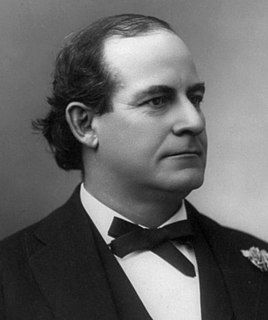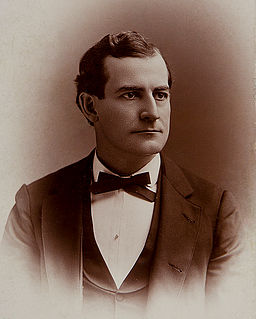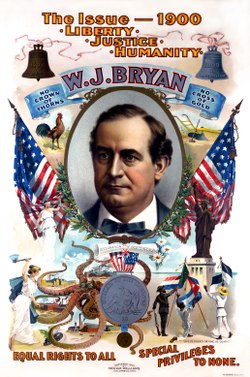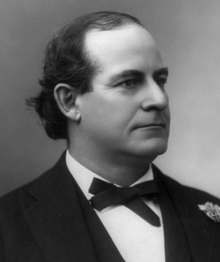
The United States presidential election of 1896 was the 28th quadrennial presidential election, held on Tuesday, November 3, 1896. Former Governor William McKinley, the Republican candidate, defeated Democrat William Jennings Bryan. The 1896 campaign, which took place during an economic depression known as the Panic of 1893, was a realigning election that ended the old Third Party System and began the Fourth Party System.

The United States presidential election of 1900 was the 29th quadrennial presidential election, held on Tuesday, November 6, 1900. In a re-match of the 1896 race, Republican President William McKinley defeated his Democratic challenger, William Jennings Bryan. McKinley's victory made him the first president to win consecutive re-election since Ulysses S. Grant had accomplished the same feat in 1872.

The United States presidential election of 1904 was the 30th quadrennial presidential election, held on Tuesday, November 8, 1904. Incumbent Republican President Theodore Roosevelt defeated the Democratic nominee, Alton B. Parker. Roosevelt's victory made him the first president to win a term in his own right after having ascended to the presidency upon the death of a predecessor.

The United States presidential election of 1908 was the 31st quadrennial presidential election, held on Tuesday, November 3, 1908. Secretary of War and Republican Party nominee William Howard Taft defeated three-time Democratic nominee William Jennings Bryan.

William Jennings Bryan was an American orator and politician from Nebraska. Beginning in 1896, he emerged as a dominant force in the Democratic Party, standing three times as the party's nominee for President of the United States. He also served in the United States House of Representatives and as the United States Secretary of State under Woodrow Wilson. Just before his death he gained national attention for attacking the teaching of evolution in the Scopes Trial. Because of his faith in the wisdom of the common people, he was often called "The Great Commoner".
The 1900 Democratic National Convention was a United States presidential nominating convention that took place the week of July 4, 1900, at Convention Hall in Kansas City, Missouri.

The 1900 United States presidential election in Missouri took place on November 6, 1900. Missouri voters chose 17 electors to represent them in the Electoral College via a popular vote pitting incumbent Republican President William McKinley against Democratic challenger William Jennings Bryan.

The 1900 United States presidential election in Pennsylvania took place on November 6, 1900. Voters chose 32 representatives, or electors to the Electoral College, who voted for president and vice president.

The 1900 United States presidential election in Montana took place on November 6, 1900. Voters chose three representatives, or electors to the Electoral College, who voted for president and vice president.

The 1900 United States presidential election in New York took place on November 6, 1900. All contemporary 45 states were part of the 1900 United States presidential election. New York voters chose 36 electors to the Electoral College, which selected the president and vice president.

The 1896 United States presidential election in New York took place on November 3, 1896. All contemporary 45 states were part of the 1896 United States presidential election. New York voters chose 36 electors to the Electoral College, which selected the president and vice president.

The 1900 United States elections elected the 57th United States Congress. The election was held during the Fourth Party System. Republicans retained control of the Presidency and both houses of Congress, while third parties suffered defeats.

The 1900 United States presidential election in New Hampshire took place on November 6, 1900 as part of the 1900 United States presidential election. Voters chose four representatives, or electors to the Electoral College, who voted for president and vice president.

The 1900 United States presidential election in Massachusetts took place on November 6, 1900 as part of the 1900 United States presidential election. Voters chose 15 representatives, or electors to the Electoral College, who voted for president and vice president.

The 1900 United States presidential election in Maine took place on November 6, 1900 as part of the 1900 United States presidential election. Voters chose six representatives, or electors to the Electoral College, who voted for president and vice president.

The 1900 United States presidential election in Rhode Island took place on November 6, 1900. Voters chose four representatives, or electors to the Electoral College, who voted for president and vice president.

The 1900 United States presidential election in New Jersey took place on November 6, 1900. Voters chose 10 representatives, or electors to the Electoral College, who voted for president and vice president.

The 1900 United States presidential election in South Carolina took place on November 6, 1900. Voters chose nine representatives, or electors, to the Electoral College, who voted for the President and Vice President.

After U.S. President William McKinley was assassinated in 1901, Theodore Roosevelt became the new U.S. President. Roosevelt's first term was notable for his trust busting, his successful arbitration in and resolution of a 1902 strike of 150,000 Pennsylvania coal miners, his advocacy against lynching, his conservation efforts, and the Panama Canal Treaty. In 1904, Roosevelt easily defeated Bourbon Democrat Alton Parker and won a second term as U.S. President.

The 1908 U.S. Presidential election occurred in the backdrop of the Progressive achievements of U.S. President Theodore Roosevelt's second term as well as against the U.S. recovery following the Panic of 1907. In this election, Roosevelt's chosen successor, Republican William Howard Taft, ran in large part on Roosevelt's Progressive legacy and decisively defeated former Congressman and three-time Democratic U.S. Presidential candidate William Jennings Bryan. Overall, the 1908 presidential campaign and election were about labor issues, trusts, campaign finance reform, imperialism, and corruption.
























